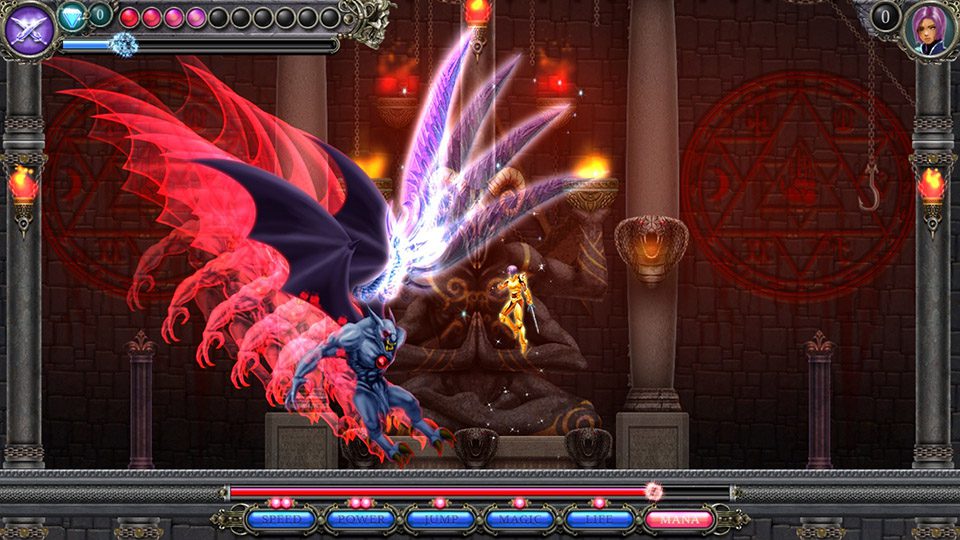The gothic action platformer Dire Vengeance released on Steam Thursday, October 14th, 2021. Developer Adam Seger of Magic Shot Games made time during the launch of their game to talk with Geeks World Wide.

Dire Vengeance looks to fall into a Castlevania style, is this accurate? If so is it more linear action or “metroidvania”?
Dire Vengeance is an action game in the style of the early linear Castlevania games, specifically Castlevania 1 and 3. We wanted to create a game that was always moving forward, giving the player new stages, bosses, weapons and obstacles. Every new area would reveal something completely new and surprising as you progress to the end of the game.
The painted art is beautiful and has a distinct style? What is the inspiration behind it? And how did it impact the game/level design or gameplay?
We both love the old-school platformers from the 80’s and 90’s and used that as the starting point for our game. While we love those old games we recognized that there was no need to limit ourselves in terms of the art. We wanted to make a beautiful, high-resolution game that is the spiritual successor to the 16-bit look that we both loved. The look of Dire Vengeance took inspiration from many varied sources including Castlevania, Super Ghouls and Ghosts, Demon’s Crest, Contra 3, Ninja Gaiden, and even Gradius. The art of H.R Geiger was a big influence. We took a lot of inspiration from ancient art and architecture from all over the world. Films were a strong guiding factor in the look of the game, specifically the Hellraiser, A Nightmare on Elm Street and the Alien franchise.
The gameplay was largely designed around the feel of the Ninja Gaiden series where you can run and slash through a level quickly without being slowed down by long combat sequences. This was paired with double jumping from Super Ghouls and Ghosts as well as the powerup system from Gradius. The Weapon System took inspiration from both Castlevania and Mega Man, as you could earn specific weapons from each boss as well as find regular subweapons throughout each level.

Pulling back from the game and talking about the development team, how big is the team? And how did you get started in game design/development?
We are primarily a 2-person team. Karl Espiritu does all of the art and game design, and Adam Seger does all of the programming. Hooman Ahmadi provided all of the music for Dire Vengeance. Karl and Adam have been friends since 2nd grade, and have had a shared love of video games and horror movies throughout their lives. Karl worked in video games at a number of companies before starting work on Dire Vengeance. Adam was trained as an electrical engineer and worked primarily on technology development before joining Karl to work on Dire Vengeance.
Dire Vengeance was on Steam Greenlight in 2016. How has the game developed and changed over the last 5 years?
When we first started making Dire Vengeance we were both relatively new to building an entire game by ourselves. Adam initially started building his own game engine to run Dire Vengeance, but quickly moved to developing on Unity after realizing how powerful it was. Dire Vengeance started life as a small platformer shooter with a character that looked like the robot from Short Circuit and could fire bullets at flying metal skulls. When we moved to Unity it transformed into the more Castlevania inspired platformer that it is today.
Where were there new opportunities for design or scope during the 5 years?
Karl is a seasoned game artist, as a team both Karl and Adam were both novices in game design and development. Opportunity grew organically through the development cycle as each of us grew in our capabilities. A good example of this is in our enemy designs. As development progressed, enemy design got more and more complex. Our first creation was the zombie. It could only walk right and left, and turn around if it sensed an edge or a wall. One of our later creations, phalangorr, reacts in real time to the player and environment. It hunts the player, and will move around obstacles to grab her. Once in its claws, the player is dragged to another enemy to be devoured. This continuous improvement not only applied to enemies, but also to the weapon system, power up bar and environmental obstacles.

What were some of the unexpected hurdles you ran into?
The biggest hurdles were not technical, but instead life events which took attention and focus away from the game. Adam started a family during the development of Dire Vengeance. Karl spent time being a full-time caregiver to his grandmother until she passed away a few years ago, right near the end of the development cycle. These events greatly impacted our time investment and even creativity as we struggled through to finish the game
If you are willing, can you share the rough cost of development for Dire Vengeance?
The monetary cost of Dire Vengeance has been quite low. There was some minor upkeep for our website and maintaining our business license. The total outlay for Dire Vengeance was probably less than $7000. However, Karl quit his regular full time job to work on Dire Vengeance full time, so the true cost counting time and lost income is significantly higher.
Finally, what’s next for you and the studio?
Continue making games! We are currently in the brainstorming phase. We have a number of ideas that we are prototyping as we decide what we want to work on next. We’ve thought about ideas as diverse as a sequel to Dire Vengeance, to a side-scrolling shooter, to an appraisal economics game.
